![]()
![]()
![]()
Use LEFT and RIGHT arrow keys to navigate between flashcards;
Use UP and DOWN arrow keys to flip the card;
H to show hint;
A reads text to speech;
163 Cards in this Set
- Front
- Back
|
What is the function of a propeller? |
To convert ENGINE TORQUE into THRUST to enable the ac to fly under it's own power Today it is mainly used to provide motive power for light ac and twin engined ac Larger ac can be powered by turbo prop engines |
|
|
What is propeller wash? |
The airflow behind a rotating propeller can be dangerous due to the extremely high speed of the moving air |
|
|
What is propeller transfixation? |
Staring at a rotating propeller can cause you to become transfixed which could lead you to wander into its path. |
|
|
What is propeller rotation? |
You must always assume that the propeller could rotate at any time, so never pass through a propeller disc. |
|
|
What is kick back? |
When hand starting a propeller, it is possible for it to kick back (spring back), so you must be in a position of safety at all times. |
|
|
What are the 4 main propeller configurations? |
1. Pusher 2. Tractor 3. Contra rotating 4. Counter rotating |
|
|
What is a pusher propeller? |
This type pushes the air frame through the air and is usually fitted behind the mainplane |
|
|
What is a tractor propeller? |
This type pulls the air frame through the air and is usually fitted forward of the main plane. |
|
|
What is a contra rotating propeller? |
There are 2 proof units on one shaft, driven by the same engine, but rotating in opposite directions. The rear prop is usually of a smaller diameter than the front prop, so the blade tops will not be affected by vertices from the front props |
|
|
What are the advantages of 9f contra rotating props. |
You can reduce the disc size whilst maintain thrust to enable lower undercarriage configurations or higher rpms from the engine due to reduced to speed. (As shorter blades the rpm can go higher to produce more thrust).
When a prop has more than 6 blades it becomes inefficient; a contra rotating prop is a method to over come this.
No rotational airflow. The 2nd set of blades straightens up the air flow sent off by the 1st set. |
|
|
What are counter rotating props? |
With a large rotating mass such as a pro, it will produce a significant turning moment or torque on the air frame. To overcome this problem on multi engined aircraft, counter rotating props are often used. In this system you would have for example the port engine prop rotating clockwise a d the starboard anti clockwise thus balancing the torque. |
|
|
From whose perspective must you look to tell what way the props are rotating. |
The pilot in the cockpit. |
|
|
What much each propeller built have? |
A logbook detailing usage and servicing history |
|
|
Wooden prop advantages |
Lightweight Rigidity economy of production Simplicity of construction Ease of placement All well suited for small ac. |
|
|
Wooden prop disadvantages |
Easily damaged Difficult to repair |
|
|
How is a wooden prop made? |
Not constructed from a solid block but built up of a number of separate layers of carefully selected and well seasoned hard wood. Each layer can be up to 3/4 inch thick. The layers are glued together with waterproof, resinous glue and allowed to set. |
|
|
What woods can a wooden prop be made from? |
MAINLY birch But also mahogany, cherry, black walnut and oak are used to some extent. |
|
|
What is added to the wooden prop once the blades are finished? |
A fabric covering is cemented to the outer 12 or 15 inches of each blade And a metal tipping is fastened to most of the leading edge and tip of each blade to protect the proof from damage caused by flying particles in the air during landing, tacking and take off. |
|
|
What metals are used for the metal tipping of wooden props? |
Template, monel metal or brass. Stainless steel has been used to some extent. |
|
|
How is the metal tipping fastened to wooden props? |
It is secured to the leading edge of the blade by counter sunk wood screws and rivets. The heads if the screws are soldered to the tipping to prevent loosening, and the solder is filled to make a smooth surface. |
|
|
What is added to metal tipping on wooden props and why? |
Since moisture condenses on the tipping between the metal and the wood, the tipping is provided with small holes near to the blade to to allow the moisture to drain away or be thrown out by centrifugal force.
It is important that these drain holes are kept open at all times. The holes are drilled with a number 60 drill about 3/16 deep. |
|
|
What are the final actions of prop creation? |
The centre hole in the hun and mounting block are carefully bored The prop is varnished. When the varnish is fully cured, the prop is balanced both horizontally and vertically. |
|
|
How are metal props manufactured? |
Forged from high strength aluminium alloy, and after being ground to their final dimensions and pitch, are anodized to protect from corrosion. The desired aerosol shape is obtained by machining and manual grinding. You twist the blades to the desired angles to set the pitch. |
|
|
Advantages and disadvantage of metal props. |
They are more expensive than wooden props however their; - increased durability - Resistance to weathering - Ability to be straightened after minor damage Have made then more cost effective in the long run. |
|
|
What material is the most widely used for props these days? |
Aluminium alloy |
|
|
What to aluminium props provide the engine with and how? |
They provide better engine cooling by carrying the aerosol sections closer to the hub and directing more air over the engine. |
|
|
When and how is an aluminium alloy prop balanced |
After the prop is ground to the desired contour It is balanced by removing some metal from the tip of the blade. |
|
|
What happens after you balance the aluminium alloy prop? |
The surfaces are finished by plating, chemical etching and or painting. Anodising is the most commonly used finishing process. |
|
|
What do some metal and composite props use to prevent erosion? |
A polyurethane sheath on the shank and onboard area of the leading edge. |
|
|
Why the need for composite props? |
For powerful turboprop engines and the demand for higher speed flight and quieter opration. |
|
|
What are the 2 constituents used in composite props |
1. Fibres 2. Matrix |
|
|
What fibrea are most commonly used for composite props |
Glass Graphite Arimid (kevlar) |
|
|
What is the matrix in composite props? |
A thermosetting resin such as epoxy. |
|
|
How are the strength and stiffness of compressors blades determined? |
By the material, diameter and orientation of the fibres. |
|
|
What does the matrix do I'm the comp blades? |
Supports the fibres, holds them in place and completely encapsulates them to protect front the environment. |
|
|
What are composite blades susceptible to? |
Lightning strikes |
|
|
What methods are used to protect comp blades from damage due to lightning strikes? |
Metal spars Erosion sheaths Metal based coatings placed over the composites that help dissipate the electricity from the lightning strike. |
|
|
What must you ensure with lightning strike protection on comp blades? |
That it is intact |
|
|
What could happen to the prop blades if they have no path to airframe ground? |
Could blow apart of struck by lightning |
|
|
What are signs of lighting strike on a comp prop? |
Dark, discoulored brown of black spot on the outer trailing edge of a blade that looks like an overheated area. |
|
|
What should you do if a lightning strike is suspected on a comp prop? |
Inspect for damage. Use gauss meter to check for residual magnetism in the ferrous attaching parts of the prop. |
|
|
What should you do if a strike is verified on a comp prop? |
Send the proo to an authorised repair facility for inspection and repair |
|
|
What are the 3 types of propeller shafts used on ac engines? |
1. Flanges propeller shaft 2. Tapered propeller shaft 3. Splined propeller shaft |
|
|
Where is the propeller attached to? |
Engine crankshaft |
|
|
What engines would you use a flanged shaft on? |
Flat/horizontally opposed and some turboprop engines |
|
|
What is a flanged prop shaft made with? |

The front of the crankshaft is formed in to a flange 4 to 8 inches across and perpendicular to the crankshaft centre line. Mounting bolt holes and dowel pin holes are machined into the flange, and on some flanges threaded insert are pressed in to the bolt holes. |
|
|
What is a tapered prop shaft and where would you find it? |
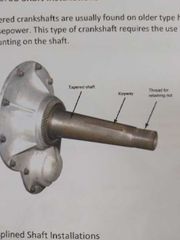
Usually found on older horizontally opposed engines of low horsepower. This type of crankshaft requires the use of a hun to adapt the for mounting on the shaft. |
|
|
Where would you find splined prop shafts and and how does it work? |
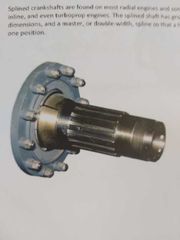
Found on most radial engines and some flat/horizontally opposed, in line and even turbo prop engines The splined shaft has grooves and splined of equal dimensions, and a master, or double width, spine so that a hub will fit in the shaft in only one position |
|
|
Draw and label a propeller |

|
|
|
Purpose of a prop |
To convert engine torque to thrust |
|
|
What is a blade root |
The area of the blade where it is faired smoothly in to the prop hub |
|
|
What is the propeller hub? |
The strong central core if the prop, it Carrie's all the blades and includes a mounting for attachment on to the engine shaft |
|
|
What is the blade shank? |
The area of the blade immediately outboard of the root it is robust, string and rounded it produce virtually NO thrust (not aerosol and doesn't turn very fast( |
|
|
What is the blade tip? |
Furthest point from the prop hub. |
|
|
What is the master station? |

The position on the blade where the blade angle is measured. (Ob back of blade) It can be determined by measurement from the hub face. |
|
|
What is an aerofoil? |
A structure with curved surfaces designed to give the most favourable ratio of lift tondrsg in flight. |
|
|
What is a leading edge? |
The foremost edge of an aerofoil, especially a wing or propeller. |
|
|
What is a trailing edge? |
The rear edge of an aerofoil. |
|
|
What is the chord line? |
An imaginary straight line joining the leading edge and trailing edge of an aerofoil. The chord length is the distance between the railing edge and the point where the chordbinterscets the leading edge. |
|
|
What is the camber? |
The asymmetry between the 2 acting surface of an aerofoil. With the top commonly more convex than the bottom. Its purpose is to produce lift. The mean camber line is the locus of points half way between the top and bottom surface. |
|
|
What is relative air flow? |
The direction of the airflow with respect to the wing direction. It is always parallel with and directly opposite to the ac flight path. |
|
|
What is the angle of attack |
The angle between the chord line of the wing and the relative airflow |
|
|
What is the plane of rotation? |
The plane if rotation of a prop is the direction it is spinning. |
|
|
What is the blade angle? |
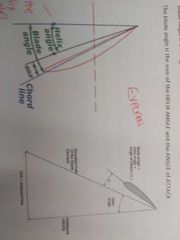
The angle between the chord line and the plane of rotation. The blade angle is the sum of the HELIX angle and the AoA. |
|
|
What is blade twist and why do we have it? |

As the blade tip travels further during each revolution than the blade root, the angle is varied from root to tip of the blade to: - ensure a uniform rate of thrust is generated from each eaction of the blade. This produces a helical shape known as blade twist. |
|
|
What is the helix angle? |
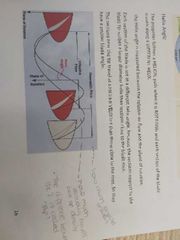
The prop follows a helical path when it is rotating and each section of the blade travels along a DIFFERENT HELIX. The helicopters angle is measured between the relative airflow and the plane of rotation. Each section of the blade is set at a different helix angle, because the sections nearest to the blade tip scribes a larger diameter helix than sections close to the root. The sections near the tip travel at a HIGHER VELOCITY than those close to the root, so they have a smaller blade angle. |
|
|
What is thrust on a prop ac? |
Mass airflow through a prop X increase in velocity of the moving airstream. The total amount of thrust produced by a prop assembly is the sum of the thrust produced by each blade. |
|
|
What are the 4 factors affecting propeller thrust? |
1. The shape of the aerofoil and smoothness of its surface. 2. The speed of the airflow over the aerofoil. 3. AoA of the aerofoil 4. Density of the air. |
|
|
Draw the prop efficiency diagram and explain. |

A propfan aircraft it's much more efficient at lower speeds however it does level off at about 400kts. The turboprop again is efficient at lower speed however it peaks at about 350kts and drops off quite quickly above this speed |
|
|
5 ways to try and improve efficiencies of props and their disadvantages |
1. Increase blade angle = only effective at one speed. 2. Fitting a blade with increased chord = weight and centrifugal twisting moment (ctm). Increase solidity, aspect ratio reduced so less efficient. 3. Increase number of blades = weight, hub, strength and solidity. 5/6 overall less efficient 4. Fitting longer blades = weight and speed of blade tips. (Supersonic) 5. Increase the camber = weight and cram increase solidity, aspect ratio reduced so less efficient.6t Increase the camber = weight and cram increase solidity, aspect ratio reduced so less efficient.6t |
|
|
What is the disc area of a prop? |
Area of the circle covered by the blade tips |
|
|
What is solidity? |
The ratio of the blade area to the disc area. The greater the solidity of the prop the greater the power that's can be absorbed. number of of blades x chord at radius ‐--------‐-‐------------------------------------------------------- Circumference at radius |
|
|
How can you increase solidity? |
- increasing the number of blades (limited by hub strength so contra rotating may be better) - increasing the chord (c130 uses 'paddle' type blades. - increasing the length of the blades (limited by tips going sonic and also ground clearance). |
|
|
What is a geometric pitch? |
The theoretical distance a prop moves forward in 1 revolution. |
|
|
What is the effective pitch? |
Because the air is not a solid the prop will not move forward the full geometric pitch.
The effective pitch is the actual distance a prop advances through the air in 1 revolution.
This can not be determined by the pitch angle alone because it is affected by the forward velocity of the ac and air density |
|
|
What is prop slip? |
The difference between geometric pitch and effective pitch. |
|
|
If a prop has a pitch of 50 inches what would the geometric pitch, effective pitch and prop efficiency be? |

In theory it should move forward 50 inches revolution. But if the ac actually moves forward only 35 inches the effective pitch is 35 inches and the propeller effeicieny is 70%.
If a propeller has an effective pitch of 35 inches and it is rotating at 1200 rpm then in 1 sec it will travel 1200160 = 20 x 35 = 700 inches |
|
|
State 3 truths for fixed pitch props. |
1. The AoA varies with the ac speed. 2. The AoA varies with engine speed. 3. Is only fully efficient at 1 ac speed. |
|
|
What must be taken in to account when setting a fixed pitch prop? |
The angle must comproise between the angles required for take off, flight and landing. |
|
|
What are the advantages of fixed pitch props? |
- easy to replace - Lightweight - cheap |
|
|
What are the disadvantages to fixed pitch props? |
- only effective at one speed -not as strong as metal - more susceptible to damage. |
|
|
To overcome the problems with fixed pitch props what can variable pitch props do? |
They can adjust the blade angle of the prop whilst the aircraft is in flight. |
|
|
What I'd the range of movement of the props controlled by? |
FINE and COARSE "PITCH STOPS". |
|
|
What do the pitch stops do? |
Limit the range of movement of the blades to the design range of the ac |
|
|
When would you use a fine pitch? |
Take off Climb Acceleration |
|
|
When would you use a coarse pitch? |
Cruising High speed flight |
|
|
What is a disadvantage of coarse pitch? |
Long take off roll |
|
|
What is a disadvantage of fine pitch props? |
Low cruise speed |
|
|
Advantages of a variable pitch prop |
Good cruise speed Short take off roll Good climb performance |
|
|
Disadvantages of variable pitch prop |
Expensive Heavy Complex |
|
|
What angles can VP prop work in? |
They can be adjusted to ANY ANGLE within the fine and coarse pitch limit stops. This is known as Constant Speed Propeller. |
|
|
Draw the performance/airspeed graph and explain |

|
|
|
Draw the pitch range diagram |
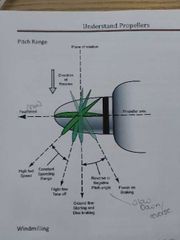
|
|
|
What is windmilling? |
Variable pitch props are prone to a condition called wind milling. If the prop suffers a loss of positive torque, the pitch will fine off in an attempt to maintain the governed RPM selected at the time. The relative airflow will impinge onto he front surface of the blade section and cause drag and negative torque that will drive the engine rather than resist rotation. |
|
|
Explain braking/reverse thrust/negative pitch |

If a propeller is turned through the fine pitch stop to around minus 20° and power applied, reverse thrust is obtained. The blade section is working inefficiently, with the total reaction being produced in the reverse direction to normal. Mechanical devices are used to prevent application of power as the propeller passes through the windmill position, until safely in braking range. The blade position is used on some enabled props to provide rapid braking after landing, and sometimes to reverse the ac out from its parked position. A mechanical lock is often incorporated to prevent the pilot selecting reverse pitch whilst airborne. |
|
|
Draw the constant speed unit and pitch change mechanism |
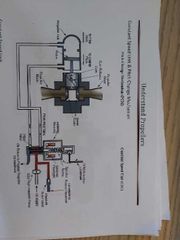
|
|
|
What is the purpose of the constant speed unit? |
To maintain a constant rpm during all flight conditions. |
|
|
What does a constant speed unit consist of? |
Retaining cup Fly weights Conical spring Service valve (oil control) |
|
|
The pilots controls are connected to the csu. What conditions will this cater for? |
Over speed On speed Underspeed |
|
|
Draw the engine on speed diagram |

|
|
|
Draw draw the engine overspeed correction |
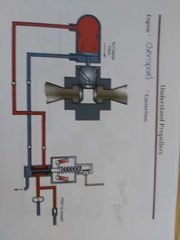
|
|
|
Draw the engine underspeed correction diagram |
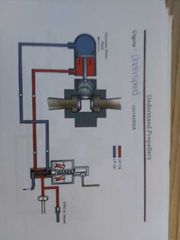
|
|
|
Draw the pitch change mechanism |
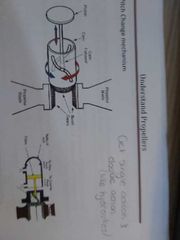
|
|
|
Explain the pitch change mechanism |
Oil to the rear of the piston moves the propeller to a fine pitch which causes the prop to speed up. Oil to the front of the piston moves the prop to a coarse pitch which causes the prop to slow down. |
|
|
What is used for overspeed protection? |
An overspeed governor is a back up for the prop governor and is mounted in the reduction gearbox. It has it's own flyweights and pilot valve, and it releases oil from the prop whenever the prop rpm exceeds a preset limit. When the prop speed reaches the limit the flyweights lift the pilot valve and bleed off prop servo pressure oil in to the reduction gearbox sump, causing the blade angle to increase. A greater pitch puts more load on the engine and slows down the prop. |
|
|
Why are propeller safety measures needed? |
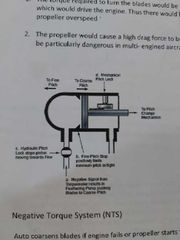
Various safety devices are fitted to override the control system should a malfunction occur.
If control was lost the propeller would slam into FINE PITCH due to centrifugal twisting moment (CTM) of the blade.
The effect of this would be dangerous in 2 respects:
1. The torque required to turn the blades would be replaced by a negative torque which would drive the engine. Thus there would be a grave danger of engine and prop overspeed.
2. The prop would cause a high drag force to be applied to the ac. This would be particularly dangerous in multi engined ac. |
|
|
What is the negative torque system? |
It auto coarsens blades if engine fails or proo starts to drive the engine by use of a Feather pump. |
|
|
What is a fine pitch stop? |
A removable physical stop. It stops the prop finding odd in flight. Can be removed for ground use (starting/reversing etc) |
|
|
What is a hydraulic pitch stop? |
If the engine fails or oil pressure is lost it stops blades finding off by trapping oil at the front of the piston |
|
|
What is a mechanical pitch lock? |
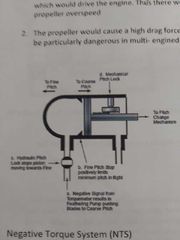
A mechanical pitch lock (ratchet) which operates when oil pressure is lost or overspeed is sensed. It still allows the blades to move coarse/feather if required. |
|
|
What are the forces acting on a prop? |
When a prop rotates, many forces interact and cause tension, twisting and bending stresses within the prop. These forces are: 1. Centrifugal force 2. Bending force (thrust) 3. Torque bending force 4. Aerodynamic twisting force (ATM) 5. Centrifugal twisting moment (CTM) |
|
|
What force puts the greatest stress on the prop and how? |
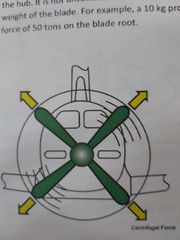
Centrifugal force as it tries to pull the blades out of the hub.
It is not uncommon for centrifugal force to be several thousand times the weight of the blade.
(Ie. A 10kg prop blade turning at 2700rpm may exert force of 50 tons on the blade root). |
|
|
What is thrust bending force? |
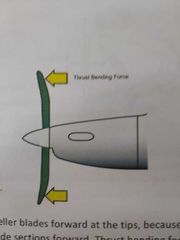
It attempts to bend the proo blades forward at the tips, because the lift toward the tip of the blade flexes the thin blade sections forward. Thrust bending force opposeds centrifugal force to some degree. |
|
|
What is torque bending force? |
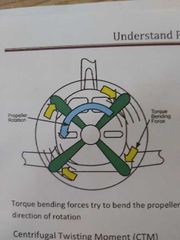
This tries to bend the prop blade back in the direction opposite the direction of rotation. |
|
|
What is CTM? |
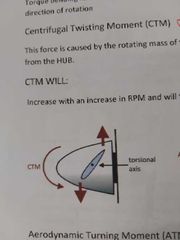
This force is caused by the rotating mass of the blades, it tends to PULL the blades away from the hub. It will increase with an increase in rpm and will try and turn the blades in to fine pitch. |
|
|
What is ATM? |
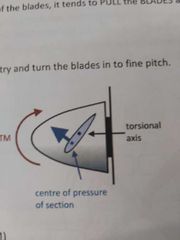
Affects the blades by turning them coarse and partially offsets CTM under normal operating conditions. CTM is always greater than ATM. |
|
|
What cause vibrations in props and what can occur if they are not designed to take this in to account. |
When a prop is producing thrust aerodynamic and mechanical forces are present which cause the blades of the prop to vibrate. If this is not taken in to account in design then these vibrations may cause excessive flexing, hardening of the metal and could result in sections of the prop breaking off during operation. Aerodynamic forces have a great vibration effect at the tip of the blade where the effects of transgenic soeeds cause buffering and vibrations |
|

What is prop ground clearance? |
The clearance that exists between the prop tip and the ground when the ac is in the normal flying attitude. On an ac with a tail wheel configuration, it would have to be in the take off position to measure the ground clearance. |
|
|
What is fuselage clearance? |
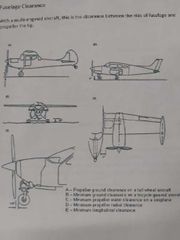
With a multi engined ac, this is the clearance between the side of the fuselage and the prop wing tip. |
|
|
What is 'swing on take off'for both nose wheel ac and tail wheel ac? |
There is often a tendency for a prop driven ac to 'swing'on take off. The causes of swing on take off are: Nose wheel ac: 1. Slipstream effect 2. Torque reaction Tail wheel ac: 1. Gyroscopic effect 2. Asymmetric blade effect |
|
|
What is the slipstream effect (corkscrew). |
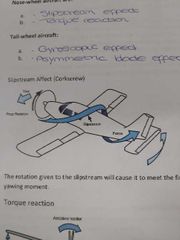
The rotation given to the slipstream will cause it to meet the fin at an angle and so cause a yawing moment. |
|
|
What is torque reaction? |
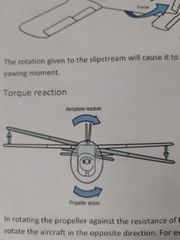
In rotating the prop against the resistance of the air, reaction is produced which tries to rotate the ac in the opposite direction. For example, with a right hand prop, the ac will tend to roll to the left. |
|
|
What is gyroscopic action/effect? |
A rotating prop has the properties of a gyro. If the plane of rotation is changed a moment will be produced at right angles to the applied moment. For example, if an ac with a right handed prop is yawed to the right it will experience a nose down pitching moment due to the gyroscopic effect of the prop. Similarly If the ac is pitched nose up, it will experience a yaw to the right. On most ac the gyroscopic effects are small and easily controlled. If torque is applied as shown then procession will occur. Direction of orecession can be determined by taking the force causing the torque and rotating it through 90° in the direction of rotation. Raising tail causes gyroscopic procession. |
|
|
What is asymmetric blade effect? |
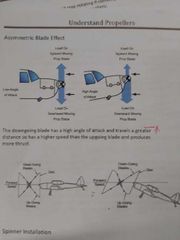
The downgoing blade has a high AoA and travels at a greater distance so has higher speed than the up going blade and produces more thrust |
|
|
Why do modern prop sc have spinnerdls? |
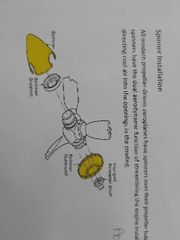
The spinners are placed over the pop hubs. These spinners have the dual aerodynamic function of streamlining the engine installation and directing cool air in to rh openings in the cowling. |
|
|
How should you install props? |
The method of installation will depend on the type of prop, and all instructions detailed in appropriate maintenance manual should be carefully followed; these will include any special checks to be carried out, and details concerning lubrication, torque loading and locking of retaining parts The engine should be ground run after installing the prop, to check for vibration and determine the engine speed obtained at full throttle. This reference rev/mm should be corrected for ambient conditions and recorded in the engine log book. |
|
|
What does blade tracking do? |
1. Reduces component wear 2. Increases ac performance 3. Reduces fatigue on pilot and ac. |
|
|
What is propeller track? |
Is the path followed by a blade segment in one rotation.
If one blade does not follow in the same track as the others. It AoA and thus thrust it produces is different, and vibration will occur. |
|
|
When should propeller track be checked? |
Should be checked on every annual and 100 hour inspection and any time vibration is a problem. |
|
|
How do you do a propeller check? |
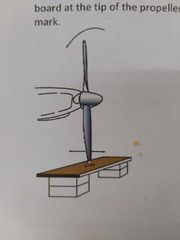
Chock the wheels so the ac cannot move and place s board under the prop so the blade tip nearly touches. Put a mark on the board at the tip of the prop and rotate the prop until the next blade is near the mark. Each blade must follow the same tr within narrow prescribed limits |
|
|
How do you tell if a prop is balanced and what were the 2 types of important balance? |
When a prop is turned by hand it should stop rotating if correctly balanced. The 2 type of I'm portant balance are: 1. Static 2. Dynamic |
|
|
What is static balance? |
A body capable of rotating about a fixed point is said to be in static balance when its centre of gravity lies in the axis of rotation. A body is in static balance if when rotated it stops at a random position each time.. |
|
|
How do you check static balance? |
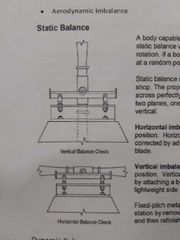
Is checked and corrected at a prop repair shop. The prop is mounted on a Mandel and placed across perfectly level knife edges. The balance is checked in 2 planes, one with the blades horizontal and one with them vertical. |
|
|
What is horizontal static imbalance? |
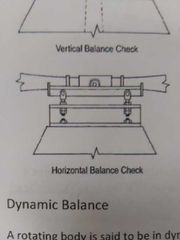
When a prop rotates to a vertical position.
Horizontal imbalance of a wood prop is corrected by adding solder to the metal tipping of the light blade. |
|
|
What is vertical static imbalance? |
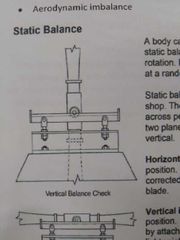
When a prop rotates to a horizontal position. Vertical imbalance of a wood prop is corrected by attaching a brass weight with counter sunk screws to the light weight side of the hub. |
|
|
How are fixed pitch metal props balanced? |
In prop repair station by removing some of the metam from the heavy side and then refinishing the prop. |
|
|
What is dynamic balance? |
A rotating body is said to be in dynamic balance when the couples set up by the centrifugal forces are in balance, ie. The algebraic sum of the moments about any plane is zero. Dynamic balance is the most effective type of balancing as it takes all of the factors into consideration. It is done with the proo installed on the engine in the ac. |
|
|
What is mass imbalance? |
Is nothing more than an imbalance in a rotating component, normally the prop that is located away from centre of the rotating mass. The further from the centre of rotation, the greater the imbalance and its destructive force |
|
|
Why do we need prop synchronisation? |
All multi engine, prop driven ac suffer from beat noise, which induces vibration in the air frame, and irritation and fatigue in crew and passengers. |
|
|
How is beat noise created? |
Is produced by the props rotating at different rpm, each prop producing it's own audible frequency which beats with the frequencies of the other props nearby. |
|
|
How can you prevent beat noise? |
These undulations can be eliminated by making the props rotate at the same speed ie. Synchronising the rpm. This was done manually, but is now done automatically by using one engine as a master reference and slaving the remaining engines to it. Each prop drives a pulse generator which provides one pulse per rev. With the props controls in the flight range, the pulses are connected.pared to the master, analysed and adjusted, by influencing the appropriate prop. As a result the noise and vibration are greatly reduced. |
|
|
Why does synchronphasing not have a significant effect on actual noise and vibration levels? |
The cause is the difference between the blades of adjacent props, being a max when adjacent blade tips are directly opposite each other. It has been found that there is optimum combinations of angular differences (phase difference) that reduce this interference to a min. The maintenance of these correct phase angles throughout normal flight range I'd known as synchronphasing . |
|
|
What are the optimum blade angle relationships? |
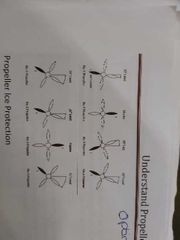
|
|
|
Why do we need prop ice elimination systems? |
To prevent of remove ice formation on prop blades during flight. If ice is allowed to remain on the blades, the efficiency of the aerofoil is reduced, the prop becomes heavier and develops an out of balance condition. These conditions can generate vibrations and cause damage to the engine and air frame. |
|
|
What are the 2 types of ice elimination? |
1. Anti icing 2 . De icing |
|
|
What is anti icing? |
Any system which PREVENTS the formation of ice on the prop. |
|
|
What is fluid anti icing? |
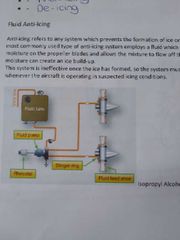
The most commonly used type of anti icing system. It employs a fluid which mixes with the moisture on the prop blades and allows the mixture to flow off the blades before the moisture can create an ice build up. |
|
|
What is a disadvantage to fluid anti icing? |
This system is ineffective once the ice has formed, so the system must be in operation whenever the ac is operating in suspected ice conditions. |
|
|
What is de icing? |
De icing refers to a system that allows ice to form and then removes the ice from the prop blades. |
|
|
What is electrical de icing/anti icing? |
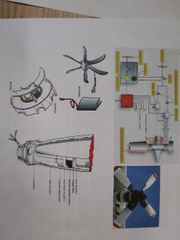
Heating elements buried in a protective coating on the blade shank and also in the spinner. It is usual to integrate the prop de icing system with the air intake. It is also usual for the prop overshot to have 2 separate heater elements, 1 for the outer portion of the blade and one for the inner. The element is protected by glass fibre and covered by oil and abrasion resistant rubber. The use of heat at the ice adhesion surface loosens the ice, which is removed by centrifugal force and the blast of the slipstream. |
|
|
Name some prop damage |
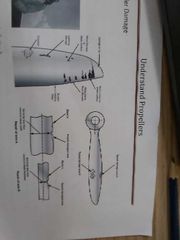
|
|
|
How do you conduct a blade repair? |
1. Visually inspect blade 2. Refer to AP for repair limits 3. Check the damage (will the blend be within limits after the repair?) 4. Remove the damage with scraper and smooth riffler file, removing all sharp edges to form a smooth blended depression. 5. Use 240 grade Emery cloth to remove traces of re work. 6. Polish with 320 grade emer cloth. 7. Reexamine with a x5 to x10 mag glass (stress raises). 8 wash blade with clean water and detergent, rinse and dry thoroughly. 9. Check repair is within AP limits. 10. Apply protective treatment (after independent inspection). |
|
|
How will you protect and preserve a prop for storage for up to 3 months? |
Props that may be out of use for a period of up to 3 months should be kept clean, and should be inspected regularly for corrosion. The internal parts of a variable pitch prop will be protected by exercising the prop during weekly engine runs, if the engine cannot be run, the proo should be feathered and untethered using the feathering pump. |
|
|
What measures should be taken if the prop is out of use for longer than 3 months? |
The prop mechanism should be flushed with inhibiting oil, and all external parts of the prop should be treated with lanolin or an approved rust preventative. The prop operating mechanism should be covered with waxed paper, and all visible parts should be regularly inspected for corrosion. |
|
|
0 - 45 hour storage plans |
No special conservation of prop is demanded. |
|
|
After 45 days prop storage plan. |
Personnel are asked to run the engine for at least 15 mins and after that to park again for next 45 days. |
|
|
46 -180 days storage plan |
Make sure the power plant has fresh oil and new oil filters before you do this preservation procedure. This removes acids and oxides that can cause damage to the engine and prop. - install restraining bridles (to prevent windmilling) - ins blade protective covers. |
|
|
After 180 days storage plan. |
If the ac should remain serviceable, depreserve the ac, run the engine for at 15 mins and preserve again. This procedure keeps the ac and prop serviceable. |
|
|
What are the long term storage plans for props? |
If storage exceeds 2 years before entering service or returning to service perform the following inspection; For all prop models: - inspect externally for damage and corrosion. Inspection may be accomplished only by a certifying mechanic. Make log book entry.
For non oil filled prop models - remove prop cylinder, inspect for internal corrosion and signs of deterioration, and repair as necessary. This must be accomplished o ly by an approved prop repair station or international equivalent IAW the appropriate prop service manual. Make logbook entry. - remove prop cylinder, inspect for internal corrosion and signs of deterioration, and repair as necessary. This must be accomplished o ly by an approved prop repair station or international equivalent IAW the appropriate prop service manual. Make logbook entry. |
|
|
What happens if the storage period exceeds 5 years? |
For all prop models, if storage period exceeds 5 years, before entering service or returning the following inspection and parts replacement: Fiassembke as necessary to replace all rubber seals and lubricants. Total disassembly (such as removing ferries from bladed) is not required unless evidence of corrosion warrants further disassembly. This must be accomplished only by an approved prop repair station or international equivalent IAW with appropriate proo service manual. Make logbook entry, inspect parts for damage and corrosion, repair/replace parts as necessary |
|
|
How should props be stored? |
With their blades in a horizontal position. If a wood prop is left with its blades in a vertical position, moisture can collect in the lower blade and cause and out if balance condition. When an ac with 3 blade constant speed props is left outside for an extended period of time, position the prop with 1 of the blades pointing down. This prevent water from collecting around a blade seal and entering the hub. Never store a prop or blades standing on the tips. DO NOT wrap the prop in any materials that seals them from airflow; an airtight wrapping promotes decay in wooden props. |
|
|
What is the prop ground running process? |
All engine running must be carried out by authorised personnel only. General operating procedures: 1. Check the ac f700 2. Inspect the engine and prop 3. check engine oil content 4. Check fuel content 5. Remove all covers and control locks as required 6. Ac position into wind and chocked 7. The area in vicinity is clear of loose artickes and equipment. 8. Check all engine ceilings and access panels are securely fitted 9. Ensure adequate fir extinguishing equipment available. |
|
|
What are the pre starting checks? |
All engine running procedures are carried out IAW relevant AP. Clearance must be obtained from ATC prior to engine start, giving: - location - people on board weather conditions must also be considered. |

